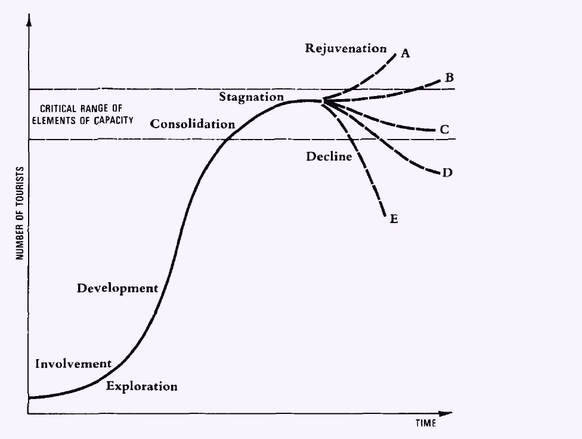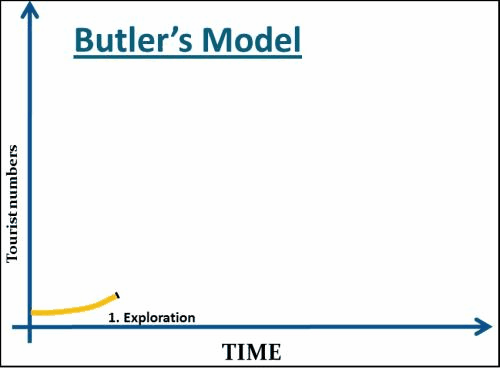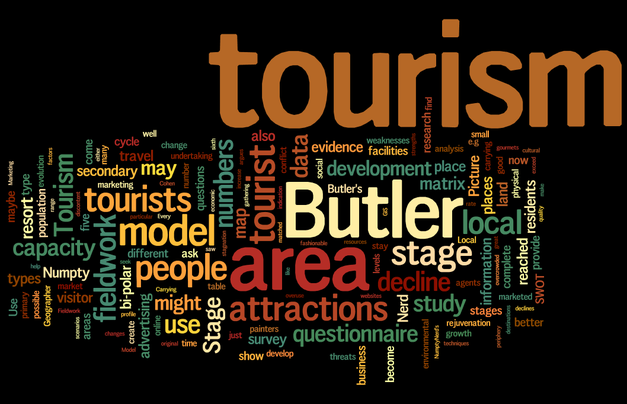Butler's Model - An Introduction
Butler's Model: The cycle of evolution of a tourist resort
Prof. Richard W. Butler's work in 1980 started a discussion about tourism carrying capacity and sustainability. He saw that tourism attractions are fragile and need to be carefully managed so that they are not allowed to exceed their capacity limits. Butler Model is about the evolution and life cycle of a tourism resort and consists of six stages. However, in the sixth stage Butler identifies a range of five possible scenarios that fit between complete rejuvenation and total decline.
The Six Stages of Tourist Area Evolution
1: The Exploration Stage
2: The Involvement Stage
3: The Development Stage
4: The Consolidation Stage
5: The Stagnation Stage
The Final Stage of the Butler Model
After reaching stagnation, Butler saw that rejuvenation or decline as possible alternatives. The last stage of his model offers five scenarios between complete rejuvenation and total decline:
A: Successful redevelopment leads to renewed growth.
B: Minor modifications to capacity levels lead to modest growth in tourism.
C: Tourism is stabilised by cutting capacity levels.
D: Continued overuse of resources and lack of investment leads to decline.
E: War, disease or other catastrophe causes an immediate collapse in tourism.
Stage 6: The Decline Scenario
Stage 6. The Rejuvenation Scenario
According to the 1980 Butler model, tourism areas leaving stage five, will either decline or rejuvenate - either way, the tourism area has evolved into the sixth stage of its development. It is misleading to identify a seventh stage in Butler's model.
Source: Numpty Nerd
1: The Exploration Stage
- Small numbers of tourists
- Based on primary tourist attractions. These maybe natural or cultural.
- No secondary tourism attractions.
- Tourism has no economic or social significance to local residents.
2: The Involvement Stage
- Local residents become involved in tourism
- Emergence of secondary tourism facilities such as guest houses.
- A tourism season may develop.
- Pressure develops for governments to improve transport for tourists.
3: The Development Stage
- High numbers of tourists that may exceed the local population during peak periods.
- Heavy advertising will create a well-defined tourist market.
- Local involvement and control of tourism declines rapidly.
- External organisations will provide secondary tourism attractions.
- Natural and cultural attractions will be developed and marketed.
- Local people experience physical changes to the area that they may not approve of.
4: The Consolidation Stage
- Tourism growth slows but the numbers of tourists exceeds the local population.
- The area's economy is tied to tourism
- Marketing and advertising will be wide-reaching.
- Major franchises and tourism chains will be represented.
- Resort areas will have a well-defined recreational business district.
- Tourism arouses opposition and discontent from some local people.
5: The Stagnation Stage
- Visitor numbers have reached their peak.
- Carrying capacity has been reached or exceeded.
- Tourism causes environmental, social and economic problems.
- The resort becomes divorced from its geographic environment.
- Artificial tourism attractions now supersede the original primary attractions.
- Area has well-established image but will no longer be fashionable.
The Final Stage of the Butler Model
After reaching stagnation, Butler saw that rejuvenation or decline as possible alternatives. The last stage of his model offers five scenarios between complete rejuvenation and total decline:
A: Successful redevelopment leads to renewed growth.
B: Minor modifications to capacity levels lead to modest growth in tourism.
C: Tourism is stabilised by cutting capacity levels.
D: Continued overuse of resources and lack of investment leads to decline.
E: War, disease or other catastrophe causes an immediate collapse in tourism.
Stage 6: The Decline Scenario
- Unable to compete with newer tourism attractions
- Holidaymakers replaced by weekend or day-trippers.
- Tourism facilities replaced by non-tourism activities.
- Hotels may become retirement homes or flats for local residents.
- Ultimately, the area may become a tourism slum or drop out of the tourism market completely.
Stage 6. The Rejuvenation Scenario
- Requires a complete change in tourism attractions.
- Previously untapped tourism resources maybe found.
According to the 1980 Butler model, tourism areas leaving stage five, will either decline or rejuvenate - either way, the tourism area has evolved into the sixth stage of its development. It is misleading to identify a seventh stage in Butler's model.
Source: Numpty Nerd



